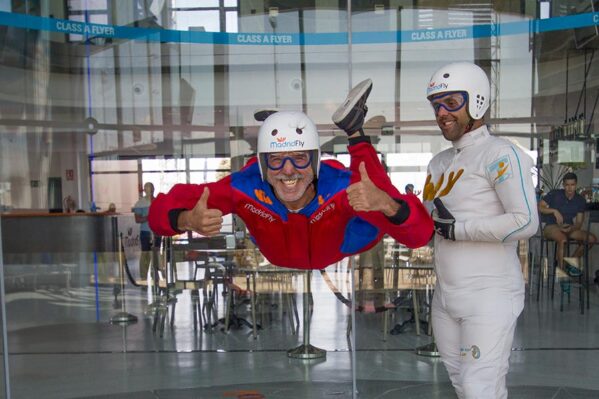Essential Information
Already Jumped Out of a Plane? Here are 5 Reasons You Should Try Indoor Skydiving
Maybe you’ve already done a tandem skydive for your bucket list, but indoor skydiving is an entirely different experience and one you don’t want to miss

[the_ad_placement id=”article-above-content-mobile-only”]
Skydiving is perhaps the most common item found on people’s bucket lists (along with activities like scuba diving and falling in love). But most people don’t realize that traditional skydiving and indoor skydiving offer two entirely different experiences, particularly as a novice flyer. Maybe you’ve already saved up the cash, steeled your nerves, and done a tandem jump outside. Now you’re thinking, “Okay, that’s that. I’ve checked skydiving off my bucket list.” Don’t be so hasty!
Jumping out of a plane is amazing (and if you’re looking for a drop zone, check out our international skydiving location database), but indoor skydiving in wind tunnels is a completely different experience, and it’s one you don’t want to miss. In this article, I’ll break down five reasons why you should try it, even if you’ve already been skydiving outside!
Indoor Skydiving is CHEAP!
Even though skydiving is a common bucket list item and jump sites are found across the country, it’s an activity that most people typically only do once because it’s so expensive. Comparatively, people are shocked when they realize how affordable a session flying in a wind tunnel is. While outdoor jumps range from $200 to $300 per person, if not more, you can hop into an indoor wind tunnel and fly for as little as $40, and sometimes even less with group discounts or coupons.
It’s almost impossible to beat that price. Think of it this way… you could experience zero gravity for five minutes in a wind tunnel, or you could buy 11 grande lattes at Starbucks. Kind of an easy choice, right?
Fly Alone Your First Time
Another big draw indoor skydiving has over traditional skydiving is that you can walk into any wind tunnel in the world and fly solo, with no instructor strapped to your back, even on your very first jump. As you can imagine, it’s simply a different experience freefalling with someone strapped to your back as opposed to flying solo like you can in a wind tunnel.
The first time you jump out of a plane, you’ll almost always have an instructor strapped to you, tandem-style. While some drop zones may offer AFF (Accelerated Freefall) courses so you can jump alone your first time, this always necessitates a hefty amount of training beforehand and close supervision is required. Almost all drop zones agree that tandem skydiving is best for one-time (i.e. bucket list) jumpers.
It takes 25 jumps and a fair amount of training to test for your U.S. Parachute Association ‘A’ license, which is required if you want to jump solo without supervision. Most other nations have similar restrictions. In indoor wind tunnels, you don’t have to mess with any of that training. You can hop in and fly alone anytime!
Experience Longer Jump Times
When you jump out of a plane you really aren’t freefalling for that long before your chute is pulled. Time varies depending on your jump altitude, but when you jump at 10,000 feet, you’ll be in freefall for around 30 seconds. From 14,000 feet that number increases to about 60 seconds and from 18,000 feet it’s about 90 seconds.
All told, most first-time jumpers can expect to experience about 60 seconds of freefall when jumping out of a plane.
In comparison, first-time flyer sessions in wind tunnels last anywhere from two to ten minutes, sometimes even longer!
Indoor skydiving allows you to experience up to 10x more time in the air, freefalling, and costs a fraction of the price, as we mentioned above. If you’re looking to explore the feeling of weightlessness, indoor skydiving offers a much more prolonged, sustained experience than traditional skydiving.
Experiment With Body Positions
Not only does indoor skydiving allow you to fly for much longer, but it allows you the freedom to experiment while you fly. When you jump out of a plane, your instructor will be focused on making sure you maintain proper spread eagle position for your 60 or so seconds of fall time before pulling your chute.
In comparison, there are always few safety precautions in place depending on the wind tunnel, but by and large, you’re free to fly however you want, even on your very first flight! You can experiment with flips and rolls and twirls and spins, and truly explore the feeling of weightlessness in a simulated freefall for minutes on end, as opposed to mere seconds.
Friends and Family Can Watch You
Another thing that sets indoor skydiving apart from traditional skydiving is the shared experience. It’s great fun for parties and gatherings, because not only can multiple people fly with you in the tunnel, but usually friends and family can watch you fly from outside the tunnel, too. This is different from normal skydiving, where the only way you can share the experience is via photos and videos (which usually cost a lot more cash on top of an already expensive jump fee) or if another person jumps with you.
Indoor skydiving lets you share the experience with everyone. Friends and family can watch from just a few feet away as you twist and twirl and fly through the air in a wind tunnel.
—–
Outdoor skydiving is amazing, but indoor skydiving is its own beast, with myriad unique factors that set it apart. Just because you’ve tried one doesn’t mean you shouldn’t try the other! Here at Indoor Skydiving Source, we hold the world’s largest and only complete up-to-date wind tunnel database, so you have everything you need to find a wind tunnel near you and start flying.
Published: July 28, 2021 | Last Updated: December 2, 2021
Don’t miss an update!
Join our mailing list for the latest indoor skydiving updates delivered directly to your inbox.
"*" indicates required fields

